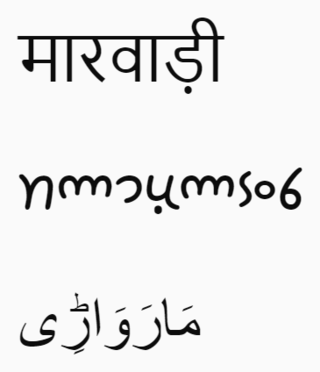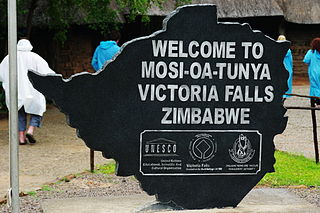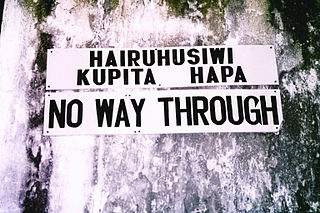Related Research Articles

The Indo-Aryan languages are a branch of the Indo-Iranian languages in the Indo-European language family. As of the early 21st century, they have more than 800 million speakers, primarily concentrated in India, Pakistan, Sri Lanka, Bangladesh, Nepal and Maldives. Moreover, apart from the Indian subcontinent, large immigrant and expatriate Indo-Aryan–speaking communities live in Northwestern Europe, Western Asia, North America, the Caribbean, Southeast Africa, Polynesia and Australia, along with several million speakers of Romani languages primarily concentrated in Southeastern Europe. There are over 200 known Indo-Aryan languages.

Gujarati is an Indo-Aryan language native to the Indian state of Gujarat and spoken predominantly by the Gujarati people. Gujarati is descended from Old Gujarati. In India, it is one of the 22 scheduled languages of the Union. It is also the official language in the state of Gujarat, as well as an official language in the union territory of Dadra and Nagar Haveli and Daman and Diu. As of 2011, Gujarati is the 6th most widely spoken language in India by number of native speakers, spoken by 55.5 million speakers which amounts to about 4.5% of the total Indian population. It is the 26th most widely spoken language in the world by number of native speakers as of 2007.

Languages spoken in the Republic of India belong to several language families, the major ones being the Indo-Aryan languages spoken by 78.05% of Indians and the Dravidian languages spoken by 19.64% of Indians; both families together are sometimes known as Indic languages. Languages spoken by the remaining 2.31% of the population belong to the Austroasiatic, Sino–Tibetan, Tai–Kadai, and a few other minor language families and isolates. According to the People's Linguistic Survey of India, India has the second highest number of languages (780), after Papua New Guinea (840). Ethnologue lists a lower number of 456.

Marwari is an Indo Aryan language of the Rajasthani languages group spoken in the Indian state of Rajasthan. It is also found in the neighbouring states of Gujarat and Haryana, some adjacent areas in Eastern parts of Pakistan, and some migrant communities in Nepal. With some 7.8 million or so speakers, it is the largest language in the Rajasthani languages group. Most speakers live in Rajasthan and a few in Nepal. There are two dozen varieties of Marwari.
The Sindhi languages or Sindhic are Sindhi, its dialects and those Indo-Aryan languages closest to it. They include some varieties traditionally considered to be Gujarati:

Saurashtra is an Indo-Aryan language spoken primarily by the Saurashtrians of Southern India who migrated from the Lata region of present-day Gujarat to south of Vindhyas in the Middle Ages.

The Bhil languages are a group of Indo-Aryan languages spoken by around 10.4 million Bhils in western and central India as of 2011. They constitute the primary languages of the southern Aravalli Range in Rajasthan and the western Satpura Range in Madhya Pradesh, northwestern Maharashtra, and southern Gujarat. According to the 52nd report of the commissioner for linguistic minorities in India, Ministry of Minority Affairs, Bhili is the most commonly spoken language of the district of Dadra and Nagar Haveli constituting 40.42% of its total population. Bhili speakers are also significant in the states of Gujarat (4.75%), Madhya Pradesh (4.93%) and Rajasthan (4.60%).

Rajasthani languages are a group of Indo-Aryan languages and dialects spoken primarily in the state of Rajasthan and adjacent areas of Haryana, Gujarat and Madhya Pradesh in India. There are also speakers in the Pakistani provinces of Punjab and Sindh. Rajasthani is also spoken to a lesser extent in Nepal where it is spoken by 25,394 people according to the 2011 Census of Nepal.
Gujarati numerals is the numeral system of the Gujarati script of South Asia, which is a derivative of Devanagari numerals. It is the official numeral system of Gujarat, India. It is also officially recognized in India and as a minor script in Pakistan.

Aer is an Indo-Aryan language spoken by around 100 people in Sindh, Pakistan and Gujarat, India. It is one of the smallest languages of Pakistan in terms of number of speakers, and is spoken in rural areas of Sindh including Hyderabad, Kot Ghulam Muhammad, and Kunri. Some speakers are also reported to be living in Shaheed Benazirabad, but they have a different culture.

Many languages are spoken, or historically have been spoken, in Zimbabwe. Since the adoption of its 2013 Constitution, Zimbabwe has 16 official languages, namely Chewa, Chibarwe, English, Kalanga, Koisan, Nambya, Ndau, Ndebele, Shangani, Shona, sign language, Sotho, Tonga, Tswana, Venda, Xhosa. The country's main languages are Shona, spoken by over 82% of the population, and Ndebele, spoken by roughly 15%. English is the country's lingua franca, used in government and business and as the main medium of instruction in schools. English is the first language of most white Zimbabweans, and is the second language of a majority of black Zimbabweans. Historically, a minority of white Zimbabweans spoke Afrikaans, Greek, Italian, Polish, and Portuguese, among other languages, while Gujarati and Hindi could be found amongst the country's Indian population. Deaf Zimbabweans commonly use one of several varieties of Zimbabwean Sign Language, with some using American Sign Language. Zimbabwean language data is based on estimates, as Zimbabwe has never conducted a census that enumerated people by language.
Vasavi is a Western Indo-Aryan language spoken by the Bhil people, though not intelligible with Bhili. The Vasavi live mainly in two districts straddling the Gujarat-Maharashtra border: Bharuch district in Gujarat and Dhule district of Maharashtra. Smaller communities may be found Vadodara and Surat districts of Gujarat and in south western Madhya Pradesh.

Tanzania is a multilingual country. There are many languages spoken in the country, none of which is spoken natively by a majority or a large plurality of the population. Swahili and English, the latter of which was inherited from colonial rule, are widely spoken as lingua francas. They serve as working languages in the country, with Swahili being the official national language. There are more speakers of Swahili than of English in Tanzania.

Kachi Koli is an Indo-Aryan language spoken in India. There is a small population of Koli who live across the border in eastern Sindh province in neighbouring Pakistan. Part of the Gujarati subfamily, Kachi Koli is closely related to Parkari Koli and Wadiyara Koli.
Parsi has been used as a name for several languages of South Asia and Iran, some of them spurious:
Rathwi Bareli is a Bhil language of India, spoken mainly in Gujarat. It is close to two other languages called Bareli, but not mutually intelligible with them. It has 81%–93% lexical similarity with Rathwi Bareli dialects, 67%–73% with Palya Bareli and 68%–79% with Pauri Bareli.
Dubli is a Bhil language of Gujarat and neighboring states. Half of ethnic Dubla speak Gujarati instead of their own ancestral tongue.

Od, also known as Oad or Odki, is an Indo-Aryan language of India and Pakistan. It is spoken by around 2 million people in Gujarat, Rajasthan, Haryana, New Delhi, Punjab and Sindh. It has similarities to Marathi, with features also shared with Gujarati and borrowings from Marwari and Punjabi.
References
- ↑ Ernst Kausen, 2006. Die Klassifikation der indogermanischen Sprachen (Microsoft Word, 133 KB)
- ↑ "Gujarati". Ethnologue. Retrieved 2018-06-06.
- ↑ Lewis, M. Paul; Gary F. Simons; Charles D. Fennig, eds. (2016). Ethnologue: Languages of the World (19th ed.). Dallas, Texas: SIL International.